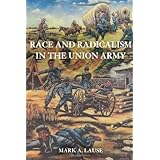
Average Reviews:

(More customer reviews)Are you looking to buy Race and Radicalism in the Union Army? Here is the right place to find the great deals. we can offer discounts of up to 90% on Race and Radicalism in the Union Army. Check out the link below:
>> Click Here to See Compare Prices and Get the Best Offers
Race and Radicalism in the Union Army ReviewOne of the year's most important books in its related subject fields of civil rights history, history of the Civil War, Labor History, Native American Studies, African-American Studies, and slavery, to mention only a few. Prof. Lause tells a good story and in this case he shines an investigative and scholarly light on a virtually unknown chapter of Civil War history that saw the first Native American, African-American, and Caucasian troops fighting side-by-side in the Civil War. "Race & Radicalism in the Union Army" recalls a little-known Union Army unit comprised of white disciples of John Brown, runaway black slaves and displaced American Indians in what later became Oklahoma near the war's front in the summer of 1863. Fighting in the Battle of Honey Springs, the Union force was outmanned 2-to-1 and still sent the Confederates retreating back to Texas in "the most significant Civil War battle fought in the Indian Territory." Lause places his subject in the context of the social and political movements of his time, revealing the warp and weft of democratic and agrarian reformers who were frequently both the propagandists and shock-troops of the War Between the States. Well-written, deeply researched and cited, "Race and Radicalism" has a useful index and will excite any scholar, student or enthusiast interested in the history within its compass.Race and Radicalism in the Union Army OverviewIn this compelling portrait of interracial activism, Mark A. Lause documents the efforts of radical followers of John Brown to construct a triracial portion of the Federal Army of the Frontier. Mobilized and inspired by the idea of a Union that would benefit all, black, Indian, and white soldiers fought side by side, achieving remarkable successes in the field. Against a backdrop of idealism, racism, greed, and the agonies and deprivations of combat, Lause examines links between radicalism and reform, on the one hand, and racialized interactions among blacks, Indians, and whites, on the other.Lause examines how this multiracial vision of American society developed on the Western frontier. Focusing on the men and women who supported Brown in territorial Kansas, Lause examines the impact of abolitionist sentiment on relations with Indians and the crucial role of nonwhites in the conflict. Through this experience, Indians, blacks, and whites began to see their destinies as interdependent, and Lause discusses the radicalizing impact of this triracial Unionism upon the military course of the war in the upper Trans-Mississippi.
The aftermath of the Civil War destroyed much of the memory of the war in the West, particularly in the Indian Territory (now Oklahoma). The opportunity for an interracial society was quashed by the government's willingness to redefine the lucrative field of Indian exploitation for military and civilian officials and contractors.
Assessing the social interrelations, ramifications, and military impact of nonwhites in the Union forces, Race and Radicalism in the Union Army explores the extent of interracial thought and activity among Americans in this period and greatly expands the historical narrative on the Civil War in the West.
Want to learn more information about Race and Radicalism in the Union Army?
>> Click Here to See All Customer Reviews & Ratings Now
0 comments:
Post a Comment